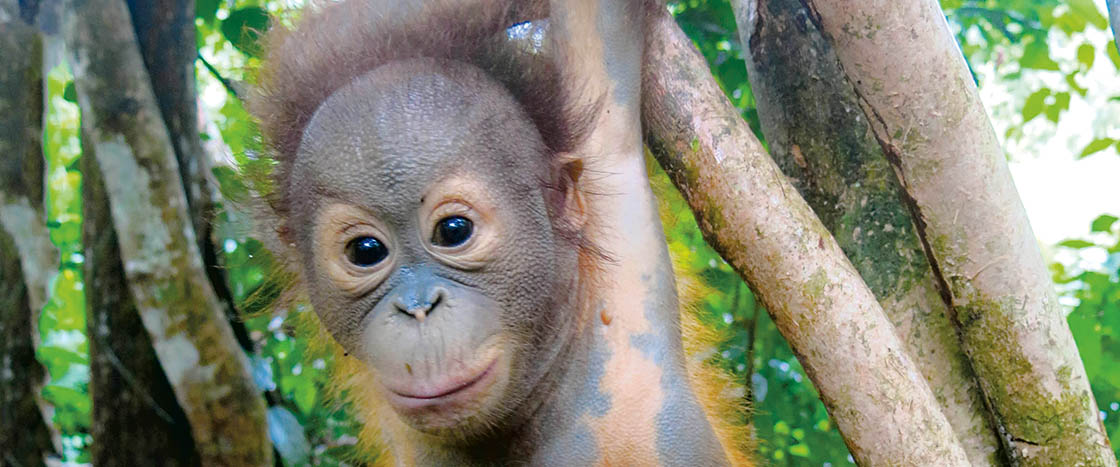Gerhana lay in the dirt—sick, starving, and alone. Death was closing in.
Just a few months earlier, the baby orangutan had been a healthy newborn. He would cling to his mother’s side as she swung through the trees in the lush rainforests of Borneo, an island in Southeast Asia. All around them, the bright-green jungle burst with life. Flying squirrels glided from tree to tree. Fluffy brown monkeys perched in the branches. Lizards the size of crocodiles darted across the forest floor. Gem-colored frogs leaped through the mud, and leopards hunted their dinner.
Baby Gerhana [guhr-HAH-nuh] and his mother snuggled together each night in a comfy nest of leaves high in the treetops.
But then one day, disaster struck.
Gerhana’s mother was killed, probably shot by a hunter hired to keep orangutans away from crops.
Sadly, this is not uncommon, as more of the rainforest where orangutans live is being destroyed. Since the 1980s, about 30 percent of Borneo’s rainforests have been cleared by humans. Hundreds of millions of trees have been cut down for timber and to make room for coal mines and palm oil plantations. (Palm oil is found in many foods and products, including pizza dough, chocolate, and toothpaste.)
For orangutans like Gerhana, this deforestation is a catastrophe. Orangutans survive on the fruits and plants that grow in the rainforest. As their habitat shrinks, so does their source of food. To avoid starvation, the apes wander into places where humans live, looking for something to eat. But many humans see the orangutans as pests—like roaches and rats—and kill them.
Without his mother, Gerhana stood little chance of survival in the wild. For the first seven or so years of life, a baby orangutan is completely dependent on its mother. The two are never apart as the mother helps her baby learn how to find food, swing through the trees, and build a nest to sleep in.
Orphaned babies are doomed. Some starve. Many others are illegally captured and sold to private zoos, where they are forced to live behind bars.
No one is sure exactly what happened to Gerhana after his mother died. It is likely that he stayed by her side. Only six months old and unable to climb trees by himself, Gerhana would have been stranded. All he could have done was cry out—miserable, starving, and alone.
But help was on the way.
Gerhana lay in the dirt. He was sick, starving, and alone. Death was closing in.
Just a few months earlier, the baby orangutan had been a healthy newborn. He would cling to his mother’s side as she swung through the trees in the rainforests. They lived in Borneo, an island in Southeast Asia. All around them, the jungle burst with life. Flying squirrels glided from tree to tree. Monkeys perched in the branches. Lizards the size of crocodiles darted across the forest floor. Gem-colored frogs leaped through the mud. Leopards hunted their dinner.
Baby Gerhana [guhr-HAH-nuh] and his mother snuggled together each night in a nest high in the trees. But one day, disaster struck. Gerhana’s mother was killed, probably shot by a hunter hired to keep orangutans away from crops.
Sadly, this is not uncommon.
Since the 1980s, about 30 percent of Borneo’s rainforests have been cleared by humans. Hundreds of millions of trees have been cut down for timber and to make room for coal mines and palm oil plantations. (Palm oil is found in many foods and products, such as pizza dough, chocolate, and toothpaste.)
For orangutans, this deforestation is a disaster. They live on the fruits and plants that grow in the rainforest. As their habitat shrinks, so does their source of food. The apes wander into places where humans live, looking for food. But many humans see the orangutans as pests—like roaches and rats—and kill them.
Without his mother, Gerhana stood little chance of survival in the wild. For the first seven or so years of life, a baby orangutan depends completely on its mother. The two are never apart. The mother helps her baby learn how to find food, swing through the trees, and build a nest to sleep in.
Orphaned babies are doomed. Some starve. Others are illegally captured and sold to private zoos, where they live behind bars.
No one knows exactly what happened to Gerhana after his mother died. It is likely that he stayed by her side. He was only six months old. He could not climb trees by himself. He would have been stranded.
But help was on the way.


